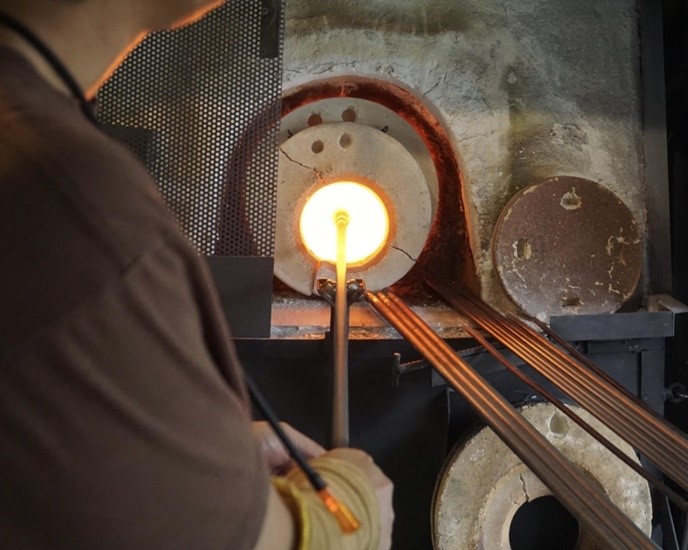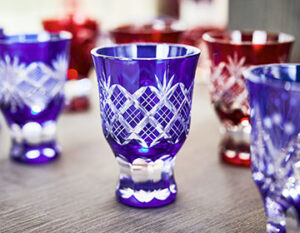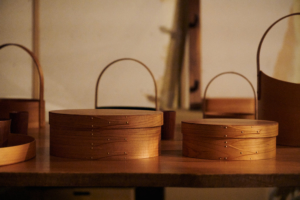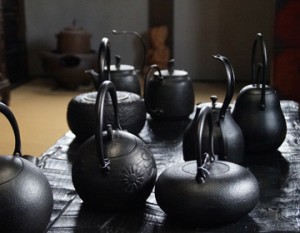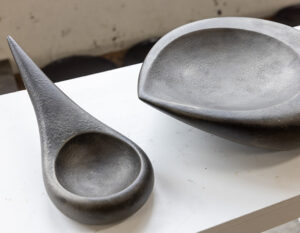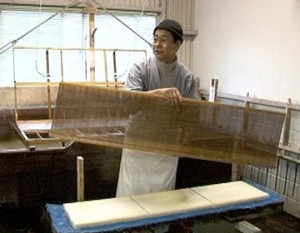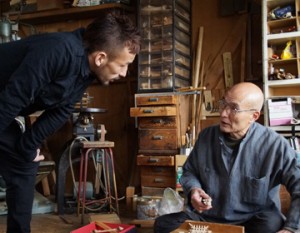Hiroi Hanaoka resides in Bizen City, Okayama Prefecture, known as the home of Bizen pottery, about a one-hour drive east from the central part of Okayama City. Near the calm sea, he operates a glassblowing studio, where he crafts popular glassware for everyday use, adorned with beautiful hues and a gentle atmosphere.
The path to glass art born from a longing for art.

Hanaoka was born and raised in Bizen City, known for its renowned Bizen pottery, making pottery the most familiar form of art in his life. Additionally, he admired his father’s hobby of painting since childhood.
Influenced by these factors, after graduating from high school, he decided to study Bizen pottery at an art university and enrolled in Kurashiki University of Science and the Arts. In the process of determining his specialization, he studied various crafts such as pottery, glass, and dyeing. Among them, he found that the speed at which glass pieces are completed the day after they are made, unlike pottery, suited his personality. Trusting this feeling, he chose the “Glass Course” and studied under Masami Kotani, the founder of Kurashiki Glass, who was serving as a professor at the time.
During his studies, Hanaoka dedicated himself to glassmaking, striving to be able to shape what he envisioned as quickly as possible. He spent extra time practicing outside of class and participated in study sessions held nationwide, immersing himself in the world of glassmaking.
Who to target and how to create

“After graduating from university, I joined the glassblowing studio ‘fresco’ run by glass artist Tsuyoshi Tsujino in Osaka. The studio valued the approach of designing glassware not only as artistic pieces but also considering how they could be seamlessly integrated into people’s lives. They prioritized total design, from creation to introducing the pieces to the world. ‘We would envision who the pieces were for and imagine the person who would pick them up while creating. We would solidify that concept first before starting production. Learning this approach was an invaluable experience for me,’ recalls Hanaoka, reflecting on that time.”
“Glass uniquely mine” or “Glass unique to this land”

After working at “fresco” for 9 years, Hanaoka established his independence in 2013. He returned to his hometown of Bizen City and opened the glassblowing studio “HIROY GLASS STUDIO,” which also features a gallery.
Hanaoka employs the technique of “free blowing,” where he shapes the glass by blowing air into a blowpipe without using molds. “With free blowing, what feels ‘right’ can vary from day to day. I think the fascinating aspect of glassblowing lies in how it can fluctuate for better or worse depending on one’s physical condition or mood,” he enthusiastically explains.
Before his studio gained momentum, Hanaoka held glassmaking classes and gradually expanded his sales channels by visiting galleries and shops with his works.
Throughout this journey, Hanaoka prioritized not only his own desires of “what he wanted to create” or “what he wanted to sell,” but also listening to the requests of others and incorporating them into his work. This flexible approach ultimately expanded the range of his creations.
The representeative series with striking slits

Hanaoka, who has always been captivated by the beauty of traditional Japanese elements since childhood, created the impressive “ren” series, inspired by the “renji” lattice found in old Japanese houses. This series features striking slit patterns reminiscent of traditional Japanese lattice work. Not only can one enjoy a variety of colors and the play of light and shadow, but the ambiguous boundaries created by the slits give the pieces a mysterious charm that seamlessly blends in wherever they are placed.
Challenging what others don’t do.

The “ren” series may initially appear similar to cut glass, but its manufacturing process is entirely different. First, colored glass is overlaid on transparent glass, heated to create glass beads, and then allowed to cool. Subsequently, the surface is cut linearly and polished before being reheated and blown to shape. This method draws inspiration from the “Graal technique” originating in Sweden. “The process of cutting before blowing is significantly different from cut glass. This allows for the inclusion of cut patterns in areas that would not be possible with cut glass,” explains Hanaoka. Due to the additional steps compared to typical glassblowing, the process requires both time and effort. By daring to challenge what others don’t do, Hanaoka has created unique pieces that are distinctly his own.
Works with connections to this land

Another important aspect for Hanaoka was the connection to his local area. Just as he had grown up with Bizen pottery, he sought to create glassworks unique to his homeland.
One year, when his parents, who were rice farmers, experienced a poor rice harvest, they had excess rice that would go to waste. Hanaoka decided to incorporate this surplus rice into his artworks. By using rice that people consume daily, he aimed to create pieces that felt familiar to the users. This led to the creation of “GRICE,” a popular series characterized by its beautiful light blue color. Currently, Hanaoka uses rice that is not suitable for market due to small grains or color discrepancies, turns it into ash, and incorporates it into the glass during production.
Interestingly, the area of Honami-Ida in Bizen City, where Hanaoka’s studio is located, was reclaimed from the sea during the Edo period. The site was once the school field “Ida” of the former Kanaya School, a school for commoners operated directly by the Okayama Domain. Through “GRICE,” Hanaoka hopes to evoke thoughts about the history imbued in this area and its connection to the local community.
Dedication to beautiful colors

Stepping into Hanaoka’s glass studio, one’s eyes are immediately drawn to the colorful glass beads hanging by the window. At first glance, they may resemble artworks, but they are actually a collection of glass color samples spanning approximately 300 hues. For coloring, powdered glass is utilized, but it’s noted that the color in its powdered form may differ from the color when it becomes glass. To ensure clarity, the glass is pre-made to accurately represent its final state. Hanaoka explains, “We use powdered glass from manufacturers in Japan as well as from Germany and the United States. For the transparent glass parts, we use raw materials from Sweden. At this point, it’s become almost like a hobby for me.” The beautiful colors seen in Hanaoka’s works originate from this meticulous process.
Dishes to enjoy according to the season

The latest series that showcases Hanaoka’s dedication to colors is called “Dusty.” With its muted tones and calming atmosphere, it seamlessly fits into various scenes of daily life. It aims to dispel the notion that glassware is only for summer by expressing the allure of glass beyond its transparency.
“Recently, there are people who enjoy using glassware according to the season,” Hanaoka happily shared. For him, the most fulfilling moments come from interacting with users who appreciate his work.
A flexible attitude breeds new creations

Ten years have passed since establishing my independent studio. Having gone through the basics of pottery, I now aim to focus more on sculptures. Initially, I wasn’t particularly skilled in creating sculptural pieces. My passion lay more in crafting functional objects for daily use.
However, delving into sculpture opened up new perspectives. People interested in sculptures also showed interest in purchasing my pottery, and vice versa. Instead of turning down opportunities with a ‘this is not my forte’ attitude, I embraced them. This flexibility led to new encounters and expanded the horizons of my work.
Moving forward, I intend to experiment with combining various series I’ve worked on before. While cherishing Japanese culture and infusing glass with beautiful colors, I will continue blowing glass, exploring new possibilities along the way.




